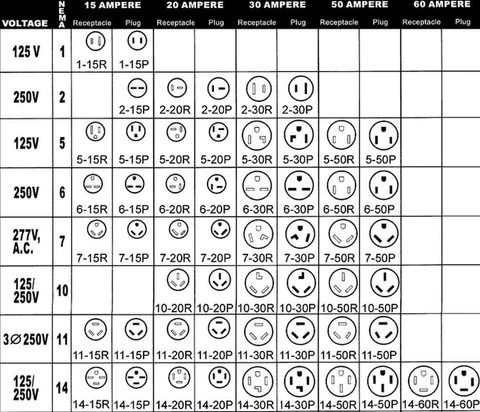NEMA Standards & History
THE EDISON DAYS – ORIGINS
In the early days of electrification, residential use was almost exclusively for illumination, with rooms normally having just a single spot in the center. Along with his lightbulb, Thomas Edison developed the Edison screw in the early 1880s, for which he received a patent in 1881. The Edison screw was very successful, and quickly became the first de facto standard for electric connection. In the early 1900s, table and floor lamps became more popular, and sockets were mounted on walls for secondary connections. One big disadvantage of screw connectors was that the cord inevitably got twisted after being connected to the receptacle.
WHAT IS NEMA?
In 1926, the National Electrical Manufacturers Association (NEMA) was founded by the merger of the Electric Power Club and the Associated Manufacturers of Electrical Supplies. This new group represented manufacturing companies of the electrical segment at a national level. NEMA provided a forum between companies for reaching standardization, but it was not until the 1940s that NEMA started to publish standards on receptacles and plugs; much later than UK, France, and Germany. Since NEMA was a forum between manufacturers and not a governmental body, any decision had to be agreed upon by its members, which substantially slowed the standardization process.
It was from this group that NEMA connectors originated from. NEMA connectors are power plugs and receptacles used for AC electrical power in the United States, Canada, Mexico, and other countries that use the standards set by the US National Electrical Manufacturers Association. NEMA wiring devices are made with ratings from 15 to 60 amperes (A) and with voltage ratings from 125 to 600 volts (V). Different combinations of contact blade widths, shapes, orientations, and dimensions create non-interchangeable connectors that are unique for each combination of voltage, electric current carrying capacity, and ground.
NOMENCLATURE
NEMA connectors are named following an alphanumeric code consisting of: prefix “L” (locking types), numerals, a hyphen, numerals, suffix “R” or “P” for “receptacle” or “plug”.
There are two basic classifications of NEMA connectors: straight-blade and locking. The metal conductive blades are often informally called “prongs” (as in “3-prong plug”). Numbers prefixed by ‘L’ are curved-blade, twist-locking connectors. Twist-locking types are used for heavy industrial and commercial equipment, where increased protection against accidental disconnection is required.
The numerals preceding the hyphen encode the number of poles (current-carrying terminals) and wires connected to it, the voltage, and single- or three-phase power. A connector with ground terminal is described as having more wires than poles, e.g. two-pole, three-wire; or four-pole, five-wire; etc. A non-grounding device may be two-pole, two-wire; three-pole, three-wire; etc.
The numerals following the hyphen is the current rating of the device in amperes. This number is followed by the letter ‘R’ to indicate a receptacle or ‘P’ to indicate a plug.
As an example, the 5-15R is the common 125 V two-pole, three-wire receptacle rated for 15 A. The L5-15R, while sharing the same electrical rating, is a locking design that is not physically compatible with the straight-blade 5-15 design. The 5-30R has the same two-pole, three-wire configuration and 125 V rating, but is rated for 30 A.
Although there are several non-grounding device types in the NEMA standards, only three of them are in widespread use today. These are the two-pole 1-15, still in use in millions of buildings built before the 1960s, and the three-pole 10-30 and 10-50.
Other types of NEMA connectors that do not follow this nomenclature include: the ML series (so-called “Midget Locking” connectors named for their diminutive size), TT (for connecting travel trailers and other recreational vehicles to external power sources), SS series (“ship-to-shore” connectors for connecting boats to shore power) and the FSL series (used in military and aircraft applications).
The small hole near the end of the power (non-ground) blades of some NEMA plugs is used for convenience in manufacturing; if present, it must be of specified diameter and position. Small specialized padlocks are available to fit these holes, allowing “lockout” of hazardous equipment, by physically preventing insertion of locked plugs into a power receptacle. Since at least 1949, numerous receptacle devices have also been invented to use these holes to hold the prongs inside the receptacle slots, using a corresponding latch or locking mechanism.
The blades of a NEMA connector are identified within the dimensional standard as follows: ‘G’ identifies the grounding conductor, ‘W’ identifies the (grounded) neutral conductor, and ‘X’, ‘Y’, and ‘Z’ are the “hot” line conductors. Single-phase connectors have only a single terminal identified as ‘X’ or two terminals, ‘X’ and ‘Y’. Three-phase connectors will use ‘X’, ‘Y’ and ‘Z’.
